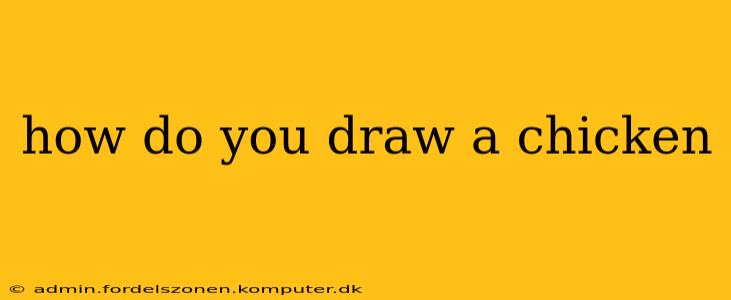How to Draw a Chicken: A Step-by-Step Guide for Beginners and Beyond
Drawing a chicken might seem daunting, but with a little guidance, you can create a charming and accurate representation of this barnyard favorite. This guide will walk you through several methods, from simple cartoon chickens to more realistic depictions, catering to different skill levels.
Understanding Chicken Anatomy: Before you start, let's briefly consider the key features of a chicken's form. This understanding will help you create a more believable drawing. Note the shape of the body (generally oval or pear-shaped), the small, triangular head, the wattle and comb (fleshy parts on the head), the beak, and the distinctive legs and feet with their claws.
Method 1: The Simple Cartoon Chicken
This method is perfect for beginners and kids. It focuses on capturing the essence of a chicken without intricate details.
- The Body: Start with a rounded oval shape for the body.
- The Head: Add a small circle slightly overlapping the top of the oval for the head.
- The Beak: Draw a small triangle underneath the circle for the beak.
- The Legs: Add two short, slightly curved lines extending from the bottom of the oval for the legs. Add small oval shapes at the bottom for the feet.
- The Comb and Wattles: Draw a simple comb (like a jagged line) on top of the head and small teardrop shapes for the wattles hanging below the beak.
- The Eyes: Add tiny dots for the eyes.
- The Wings: If desired, add a small wing shape extending from the side of the body.
Method 2: A More Realistic Chicken
This method involves more detail and shaping to create a more lifelike chicken.
- The Body: Begin with a slightly elongated oval, broader at the bottom, for the body. This reflects the chicken's posture.
- The Neck: Draw a curved line connecting the head to the body, indicating a slightly longer neck.
- The Head: Draw a smaller, somewhat triangular head on top of the neck.
- The Beak: Add a more detailed beak, considering its shape and slight curvature.
- The Legs and Feet: Draw longer, more slender legs than in the cartoon version, curving slightly outwards. Pay attention to the placement and shape of the toes and claws.
- The Comb and Wattles: Draw a more detailed and textured comb, adding ridges and variations in its shape. Add fuller wattle shapes, considering how they hang and fold.
- The Feathers: Suggest feathers by drawing lightly curved lines radiating from the body, especially around the wings and tail area.
- The Eyes: Add more detailed eyes, possibly adding highlights to give them depth.
What materials should I use to draw a chicken?
You can use various materials depending on your preference and the desired effect. Pencils (ranging in hardness), charcoal, pens, and even pastels can all be effectively used to draw chickens. Consider using a light pencil sketch initially to ensure your proportions are correct before adding darker lines or colour.
How can I improve my chicken drawings?
Practice is key! The more you draw, the better you will become at understanding proportions and adding detail. Study real chickens, photographs, or even videos to observe their movements and poses. Try different angles and perspectives to challenge yourself. Don't be afraid to experiment with different drawing techniques and styles.
What are some common mistakes when drawing chickens?
- Incorrect proportions: The head is too big or small relative to the body. The legs are too short or too long.
- Lack of detail: The drawing appears flat and lacks texture or shading.
- Unnatural posture: The chicken’s pose looks stiff or unrealistic.
By following these steps and practicing regularly, you'll be well on your way to creating wonderful chicken drawings, regardless of your skill level. Remember, have fun and don't be afraid to experiment!
